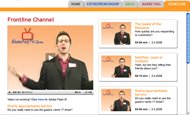 Not compliance – commitment.
Not compliance – commitment.
Huge difference.
As I learned from The Power of Strategic Commitment:
“Commitment is the innate willingness of people to follow and contribute; compliance is the forced adherence to plans created through manipulation, punishment and coercion.”
That’s the difference between doing the job a delivering the brand.
THE PROBLEM IS: Zero commitment means zero engagement, and zero engagement means zero profits.
Today we’re going to explore seven strategies to help you inspire commitment in the hearts of the people who matter most:1. Start at the top. The reason commitment is improperly installed in most organizations is because it’s treated as policy, not a lifestyle. Unfortunately, that’s not the way commitment works. It’s not something you do – it’s something you embody. And unless it’s a robust strand of the leader’s genetic makeup, people won’t be inspired to follow suit.
That’s what I’ve learned after ten years of wearing a nametag: Commitment is the offspring of values. You really think I’d still be wearing this stupid sticker every day if it weren’t directly glued to my personal constitution? Hell no. But that’s the whole point: When it’s your heart, you don’t need to prove to anyone that you can’t live without it. They simply take the cue from your life.
Therefore, if you want to inspire commitment from the people who matter most, begin by expressing your own. Find your commitment device. And wear it proudly for all to see. Otherwise you may as well be winking in the dark.
Remember: The problem isn’t a fear of commitment – but a failure to communicate that you’re fully committed. How are you cascading your commitment through every level of the organization?
2. Worthwhile trumps importance. Any work can be important. Think about the most meaningless job you ever had in your life – it was probably important to someone. Worthwhile work, on the other hand, covers more emotional territory. It doesn’t just hold importance – it’s has impact. And the fruit of your worthwhile labor becomes a gift to your people.
To achieve that kind of result in your organization, try this: Give people work that demands the best, highest version of themselves. Tap into the wellspring of their unique capability. I promise: They’ll have no choice but to thrust themselves into uncharted waters – remaining fully engaged the whole time. Otherwise, the work you ask them to do becomes nothing more than another line item on their task list.
And I’m not suggesting your company tries to spin people’s work experience into something it’s not. Instead, I challenge you to excavate the worthwhileness of what your people do. Because if you dig deep enough and come up with nothing but “important,” then it’s probably not work that matters in the first place. Do your people see their work as a daily grind to or daring gateway?
3. People are craving for transcendence. If you want your people to show up when they’re exhausted – not just expected – you have to appeal to their fundamental desire for work that has meaning. After all, people engage when they’ve been given permission to flex the muscle of why. And by actively cultivating the purpose driven nature of their work, you provide deeper context for all their effort.
The question you have to ask yourself every day: To what extent are your people anchored in purpose? Because if they’re not, you can expect about as much commitment a kamikaze pilot on his thirty-ninth mission. And I’m not saying purpose is a panacea. But life’s heaviest burden is having nothing to carry.
Look: People want to be in love. Nobody wants to spend a third of her life in an activity that has no meaning. Work should be a place of fulfillment – not sacrifice. Is working for you something to be endured or enjoyed?
4. Flush out the fear. Chronically fearful people don’t commit. And people withdraw allegiance when they feel afraid. According to Dr. Judith Bardwick, author of One Foot Out The Door, fearful people can’t perform at their best because fear destroys the wherewithal to do their best work.
That’s the danger in being known as an emotional time bomb: The people around you disengage, walk on eggshells and burn all their time looking over their shoulder – instead of executing what matters.
If you want your people to stop complying and start committing, begin by taking radical responsibility for your attitude. I’m not suggesting you suppress or ignore your emotions – but stepping away from some of the stress might make communicating with you a more relaxing experience.
Remember: Comfort precedes intimacy and intimacy strengthens commitment. Stop wearing your anger as an accessory. You’re scaring people. What can you control that your people are afraid of?
5. Payment isn’t the panacea. It’s easy to scapegoat lack of commitment on lack of compensation. But as I learned from aforementioned Power of Strategic Commitment, “Giving people more money does nothing but make them wealthier unhappy people.”
Think of it like a bottle of Febreeze: You spray it on smoky clothing when you get home from the bar. The only problem is, the next day all you have is a shirt that smells like Febreeze – and smoke. You didn’t change the fundamental nature of anything; you just put a layer of chemicals over it.
The same goes for inspiring commitment: It’s not for sale. If you really want people to engage wholeheartedly, enable authorship – not just readership. After all, people always commit to what they help create. And they’re always willing to invest in what they truly admire.
But they’ll never experience emotional fulfillment until you enable their passions to remain an integral part of their worklife. That’s the other distinction between compliance and commitment: One is taking a job – the other is undertaking a crusade. Are your people receiving a substantial return on their emotional investment?
6. Understand motivation in today’s workplace. As a leader, you can’t motive people to do anything – all you can do is find people who are already motivated and inspire them to motivate themselves. My suggestion is to delete people’s demotivators first. A few examples come to mind:
Delivering constant criticism, raising your voice, magnifying their mistakes, exhibiting lack of trust, prohibiting any shred of playfulness, making people feel powerless, refusing to recognize success and compensating less for working more.
Then, once you’ve cleared away the crap, here’s the next step: Pinpoint people’s passion and embed that passion into the pavement that leads the way. By finding out what fuels people – you know what to fill the tank with when they start puttering along.
Remember: All motivation is self-motivation. People don’t change just because you want them to – they change because they want to. And because the pain of staying the same outweighs the cost of modifying their behavior. Are your people comfortable exploring their own opportunities for development?
7. Anonymity is bankruptcy. Absence doesn’t make the heart grow fonder – it makes the mind start to wonder. That’s what happens when you leave people in the dark: They engage in worse case thinking.
Take my parents, for example. If they haven’t heard from me in a few days, they freak out. And a barrage of texts, emails and instant messages come pouring in, asking me if I’m okay. Which I am. But you’ve got to think about it from a parent’s perspective: The way they see it, no news is bad news. And as a son, that’s something I’ve had to work on. Fortunately, I’m learning to be more proactive in volunteering information.
My question is: Are you prolific in your communication?
If not, try this: Instead of hoping people will read your mind and then recommend the decision you’ve already decided on, stop restricting the flow of information. Just talk to people. You’ll turn awkward moments of silence into opportunities for honest conversation.
Also, quicken your response time. And remember that the medium is the message. Because it’s not just what you say, it’s not just how you say it – it’s how quickly you get back to people, and how they feel when they hear it.
That’s the holistic way to look at communication: Content, context, delivery and reception. All four must be attended to. Because in the absence of communication, people will make up their own. Is your anonymity alienating the people who matter most?
REMEMBER: When you inspire commitment to the brand inside the organization, you inspire belief in the brand outside the organization.
That’s when you stop making money and start making history.
LET ME ASK YA THIS…
How much engagement is your organization hemorrhaging due to weak commitment?
LET ME SUGGEST THIS…
For the list called, “68 Things Employees Never Want to Hear You Say,” send an email to me, and I’ll send you the list for free!
* * * *
Scott Ginsberg
That Guy with the Nametag
Author, Speaker, Entrepreneur, Mentor
[email protected]
Tune in to The Frontline Channel on NametagTV.com!
Watch video lessons on delivering unforgettable service!


 Every leader has an audience.
Every leader has an audience. The world’s FIRST two-in-one, flip-flop book!
The world’s FIRST two-in-one, flip-flop book! You can only talk to yourself for so long.
You can only talk to yourself for so long. The world’s FIRST two-in-one, flip-flop book!
The world’s FIRST two-in-one, flip-flop book!